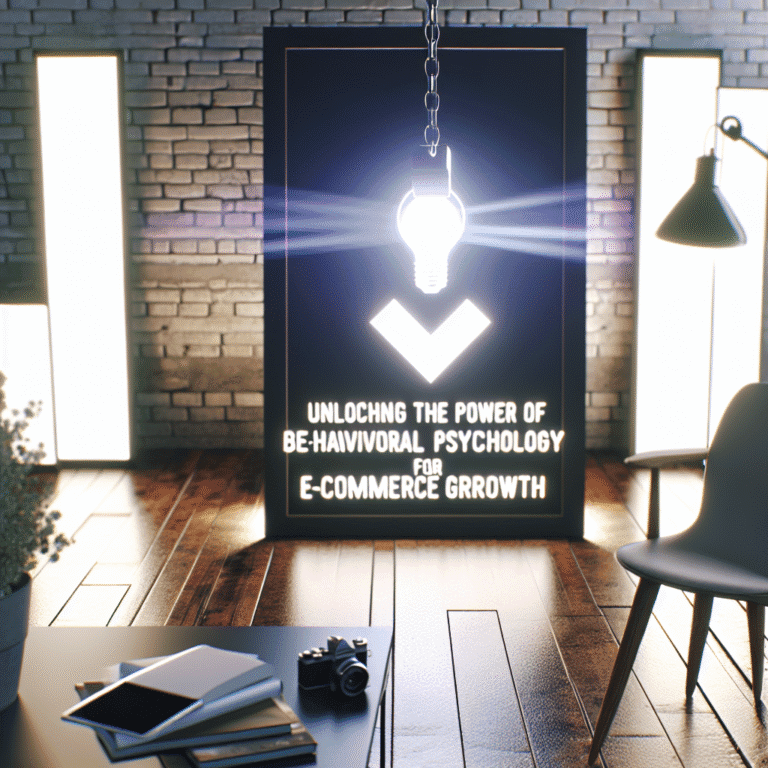Feeling stuck in a rut with your online store’s growth? You’re not alone. Even seasoned ecommerce professionals can struggle to identify areas for improvement. But what if there was a secret weapon to unlock your online store’s true potential? Enter ecommerce optimisation. By implementing strategic refinements to your website and marketing strategies, you can streamline the customer journey, boost conversions, and watch your sales soar. This comprehensive guide dives deep into the world of ecommerce optimisation, equipping you with actionable tactics and expert insights to transform your online store into a thriving success story.
Unlocking the Potential of Ecommerce Optimisation
Ecommerce optimisation is the ongoing process of refining your online store to enhance its performance and profitability. It’s about identifying areas for improvement and implementing strategies to:
- Increase conversion rates: The percentage of visitors who make a purchase.
- Improve average order value (AOV): The average amount spent per order.
- Reduce basket abandonment: When customers add items to their basket but don’t complete the purchase.
- Boost customer lifetime value (CLTV): The total revenue a customer generates over their relationship with your brand.
By optimising your ecommerce store, you can create a more seamless and enjoyable shopping experience for your customers, ultimately leading to increased sales and a thriving online business.
Optimising Your Ecommerce Website for Conversions
Here’s where the magic happens! In this section, we’ll delve into specific tactics you can implement to optimise your website for conversions. We’ll cover:
- Enhancing user experience (UX) to encourage seamless navigation and checkout processes. (h3)
- Utilising persuasive call-to-action buttons and compelling product descriptions. (h3)
- Incorporating customer reviews and testimonials to build trust and credibility. (h3)
Enhancing User Experience (UX) to Encourage Seamless Navigation and Checkout Processes
A user-friendly website is the cornerstone of a successful ecommerce store. Imagine walking into a physical shop where the aisles are cluttered, products are haphazardly displayed, and finding a salesperson is an Olympic feat. Not exactly an inviting shopping experience, right? The same applies to your online store.
A well-designed website with intuitive UX prioritises the customer journey, making it easy for them to find what they need, navigate seamlessly, and complete their purchases effortlessly. Here’s how to optimise your UX for maximum conversion:
- Clear and Concise Navigation:
- Your website’s navigation menu should be crystal clear, with easily identifiable categories and subcategories. Think of it as a roadmap guiding visitors to their desired products. According to a Baymard Institute study, a whopping 61% of users abandon websites because they can’t find what they’re looking for.
- Consider using a mega menu for extensive product categories, but ensure it doesn’t overwhelm visitors with too many options.
- Fast Page Load Times:
- Nobody enjoys waiting for a website to load, especially in today’s fast-paced world. Studies by Akamai show that a 100ms delay in mobile page load time can lead to a 7% drop in conversions.
- Optimise your website images, compress files, and leverage a reliable web hosting service to ensure lightning-fast page load speeds.
- High-Quality Product Images and Descriptions:
- Compelling product visuals are essential for grabbing attention and showcasing your products in their best light. Invest in high-resolution images from multiple angles, allowing customers to zoom in for detailed viewing.
- Craft clear and concise product descriptions that highlight key features, benefits, and specifications. Use engaging language that speaks to your target audience and avoids excessive jargon.
- Search Functionality:
- A robust search bar empowers customers to quickly find specific products. Ensure your search function is user-friendly, offering auto-suggestions and filtering options by category, price, and brand.
- Simple and Secure Checkout Process:
- The checkout process should be streamlined and free of unnecessary steps. Limit the number of required forms and offer guest checkout options for faster transactions.
- Most importantly, ensure a secure checkout process that instills trust in your customers. Display trust signals like SSL certificates and secure payment gateways.
Remember, a positive user experience goes beyond just these points. It’s about understanding your target audience’s needs and pain points, and then tailoring your website to address them effectively. By prioritising user-friendliness and a seamless shopping journey, you’ll encourage conversions and keep customers coming back for more.
Utilising Persuasive Call-to-Action Buttons and Compelling Product Descriptions
Your website visitors are bombarded with information every day. So, how do you cut through the noise and convince them to take action? This is where compelling calls to action (CTAs) and product descriptions come
Utilising Persuasive Call-to-Action Buttons and Compelling Product Descriptions
Your website visitors are bombarded with information every day. So, how do you cut through the noise and convince them to take action? This is where compelling calls to action (CTAs) and product descriptions come in. They’re the final nudge that can turn website browsers into paying customers.
Crafting Clear and Compelling CTAs:
- Action Verbs:
- Use strong action verbs that leave no room for doubt about what you want visitors to do. Think “Buy Now,” “Add to Basket,” or “Start Your Free Trial” instead of generic options like “Submit” or “Click Here.”
- Benefit-Driven Language:
- Don’t just tell visitors what to do, tell them what they’ll get out of it. Frame your CTAs around the benefits of taking action. For example, “Upgrade Now for Faster Shipping” or “Download Your Free Guide to Better Sleep.”
- Sense of Urgency:
- Sometimes, a gentle nudge can create a sense of urgency and encourage conversions. Consider using phrases like “Limited Time Offer” or “Only a Few Left in Stock” without resorting to excessive pressure tactics.
- Clear Design and Placement:
- Your CTAs should be visually distinct from the rest of your website content. Use contrasting colours, clear fonts, and strategic placement to ensure they grab attention.
Writing Product Descriptions that Convert:
- Focus on Benefits, Not Just Features:
- People don’t buy products; they buy the solutions those products provide. Don’t just list features; tell visitors how your product will improve their lives. For example, instead of simply stating “Wireless headphones with 10-hour battery life,” focus on the benefit: “Enjoy uninterrupted music and calls for hours on end with our wireless headphones.”
- Speak to Your Target Audience:
- Understand your ideal customer’s pain points and desires. Use language that resonates with them and addresses their specific needs.
- Highlight Unique Selling Points (USPs):
- What makes your product stand out from the competition? Showcase your USPs in your product descriptions to give visitors a compelling reason to choose you.
- Use Emotional Language:
- People make emotional decisions, even when they justify them logically. Weave emotions like excitement, security, or confidence into your product descriptions to create a connection with potential customers.
- Keep it Concise and Scannable:
- Attention spans are short online. Craft clear and concise product descriptions that are easy to read and scannable at a glance. Use bullet points, bold text, and clear headings to break up the text and improve readability.
By implementing these tips, you can craft CTAs and product descriptions that are informative, persuasive, and designed to drive conversions.
Incorporating Customer Reviews and Testimonials to Build Trust and Credibility
In today’s digital age, customers are increasingly wary of online businesses. Social proof, in the form of customer reviews and testimonials, can be a powerful tool for building trust and credibility. Here’s how to leverage them effectively:
- Display Prominently:
- Don’t hide your positive reviews! Showcase them on product pages, your homepage, and throughout your website.
- Encourage Customer Reviews:
- Make it easy for customers to leave reviews after they’ve made a purchase. Send automated email requests or offer incentives for leaving feedback.
- Respond to Reviews (Positive and Negative):
- Taking the time to respond to reviews shows customers you care about their feedback. Thank them for positive reviews and address any concerns raised in negative reviews in a professional and helpful manner.
- Showcase Video Testimonials:
- Video testimonials add a personal touch and can be even more impactful than written reviews. Feature satisfied customers talking about their positive experiences with your brand.
By incorporating social proof elements like customer reviews and testimonials, you can build trust with potential customers and give them the confidence to buy from your online store.
Enchancing Ecommerce Product Pages for Maximum Impact
Product pages are your online storefront’s sales pitches. This is where you have the opportunity to showcase your products in all their glory and convince visitors to add them to their basket. Here are some key strategies for optimising your product pages:
- High-Quality Product Images:
- Visuals are crucial for ecommerce. Invest in high-resolution product photography from multiple angles. Include close-up shots to showcase details, lifestyle images to demonstrate product use in real-world scenarios, and 360-degree views for a truly immersive experience.
- Mobile-Friendly Design:
- With the ever-increasing dominance of mobile shopping, ensuring your product pages are responsive and user-friendly on all devices is paramount. Test your product pages on various screen sizes and devices to guarantee a seamless experience for mobile users.
- Compelling Product Videos:
- Take your product presentations a step further with high-quality product videos. Showcase product features in action, highlight benefits, and use storytelling to engage viewers emotionally.
- Clear and Concise Product Information:
- Provide all the essential information potential customers need to make informed decisions. This includes accurate product descriptions, specifications, sizing charts (for clothing), dimensions, materials, and care instructions.
- Social Proof Elements:
- Strategically integrate customer reviews, ratings, and star-based systems to build trust and encourage conversions. Consider displaying user-generated content (UGC) like social media posts featuring your products to add authenticity.
- Upselling and Cross-Selling:
- Recommend complementary products that enhance the customer’s experience with your main product (cross-selling). For example, suggest a phone case alongside a new smartphone purchase. Upselling involves showcasing premium versions of the product being viewed or similar products with higher price points.
- Scarcity and Urgency:
- Subtly implement tactics that create a sense of urgency and scarcity to encourage immediate action. This could involve limited-time offers, displaying low stock availability, or highlighting upcoming price increases. Be mindful not to resort to pressure tactics, and ensure these elements are truthful.
Building a Dream Team: The Power of Collaboration in Ecommerce
Even the most experienced ecommerce entrepreneur can benefit from a helping hand. The ecommerce landscape is constantly evolving, and seeking help from specialists can unlock a wealth of expertise and propel your online store to new heights. Here are some key ecommerce specialists you might consider adding to your team:
- Content Marketing Specialists:
- They craft compelling product descriptions, blog posts, and email campaigns that resonate with your target audience and drive conversions.
- SEO Experts:
- Search Engine Optimisation (SEO) is an ever-changing game. An SEO expert can ensure your online store ranks high in search engine results pages (SERPs), attracting organic traffic and potential customers.
- Pay-Per-Click (PPC) Specialists:
- PPC advertising allows you to target your ideal customers with laser precision. A PPC specialist can manage your campaigns effectively, maximize your return on investment (ROI), and ensure you get the most bang for your buck.
- Web Developers:
- A skilled web developer ensures your online store is not only visually appealing but also functions flawlessly across all devices. They can handle technical aspects, website maintenance, and implement security measures to safeguard your store and customer data.
- Data Analysts:
- Ecommerce generates a wealth of data. Data analysts can help you interpret this data, identify trends, and unlock valuable insights to optimize your marketing strategies, product offerings, and overall customer experience.
- Social Media Marketers:
- A social media marketing specialist can help you use the power of social media platforms to connect with your target audience, build brand awareness, and drive traffic to your online store.
Remember, your dream team doesn’t have to be a permanent staff. Consider freelance marketplaces or agencies to access specialised skills on a project-by-project basis. The key takeaway is that collaboration is key. By surrounding yourself with skilled professionals who complement your strengths, you can tackle challenges more effectively and achieve remarkable success in the dynamic world of ecommerce.
Conclusion
Ecommerce optimisation is an ongoing process, but by implementing the strategies outlined in this guide, you can take your online store to the next level. Focus on creating a seamless user experience, craft compelling product descriptions and CTAs, leverage social proof, and optimise your product pages for maximum impact. Remember, collaboration is king





